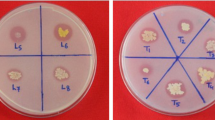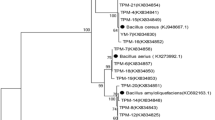Abstract
The morphological, biochemical, and physiological characteristics of a phosphate solubilizing and antagonistic bacterial strain, designated as B0, isolated from a sub-alpine Himalayan forest site have been described. The isolate is gram negative, rod shaped, 0.8 × 1.6 μm in size, and psychrotrophic in nature that could grow from 0 to 35°C (optimum temp. 25°C). It exhibited tolerance to a wide pH range (3–12; optimum 8.0) and salt concentration up to 4% (w/v). Although it was sensitive to kanamycin, gentamicin, and streptomycin (<10 μg mL−1), it showed resistance to higher concentrations of ampicillin, penicillin, and carbenicillin (>1000 μg mL−1). The isolate showed maximum similarity with Pseudomonas putida based on 16S rRNA analysis. It solubilized tricalcium phosphate under in vitro conditions. The phosphate solubilization was estimated along a temperature range (4–28°C), and maximum activity (247 μg mL−1) was recorded at 21°C after 15 days of incubation. The phosphate solubilizing activity coincided with a concomitant decrease in pH of the medium. The isolate also exhibited antifungal activity against phytopathogenic fungi in Petri dish assays and produced chitinase, ß-l,3-glucanase, salicylic acid, siderophore, and hydrogen cyanide. The plant growth promotion and antifungal properties were demonstrated through a maize-based bioassay under greenhouse conditions. Although the bacterial inoculation was found to result in significant increment in plant biomass, it stimulated bacterial and suppressed fungal counts in the rhizosphere. The present study is important with respect to enumerating microbial diversity of the colder regions as well as understanding the potential biotechnological applications of native microbes.



Similar content being viewed by others
Literature Cited
Bano N, Musarrat J (2003) Characterization of a new Pseudomonas aeruginosa strain NJ-15 as a potential biocontrol agent. Curr Microbiol 46:324–328
Buyer JS, Sikora LJ, Kratzke MG (1990) Monoclonal antibodies to ferric pseudobactin, the siderophore of plant growth promoting Pseudomonas putida B10. Appl Environ Microbiol 56:419–424
Collins CH, Lyne PM (1980) Microbiological methods.: Butterworth and Co. (Publishers) Ltd London
Ellis RJ, Timms-Wilson TM, Bailey MJ (2000) Identification of conserved traits in fluorescent pseudomonads with antifungal activity. Environ Microbiol 2:274–284
Illmer P, Barbato A, Schinner F (1995) Solubilization of hardly-soluble AIPO 4 with P-solubilizing microorganisms. Soil Biol Biochem 27:265–270
Kluepfel DA (1993) The behaviour and tracking of bacteria in the rhizosphere. Annu Rev Phytopathol 31:441–472
Lim H, Kim Y, Kim S (1991) Pseudomonas stutzeri YLP-1 genetic transformation and antifungal mechanism against Fusarium solani, an agent of plant root rot. Appl Environ Microbiol 57:510–516
Meyer JM (2000) Pyoverdines: pigments, siderophores and potential taxonomic markers of fluorescent Pseudomonas species. Arch Microbiol 137:1135–1142
Meyer JM, Azelvandre P, Georges C (1992) Iron metabolism in Pseudomonas: salicylic acid, a siderophore of Pseudomonas fluorescent CHAO. Biofactors 4:23–27
Molina L, Ramos C, Duque E, Ronchel MC, Garcia M, Wyke L, Ramos JL (2000) Survival of Pseudomonas putida KT2440 in soil and in the rhizosphere of plants under greenhouse and environmental conditions. Soil Biol Biochem 32:315–321
Nagarajkumar M, Bhaskaran R, Velazhahan R (2004) Involvement of secondary metabolites and extracellular lytic enzymes produced by Pseudomonas fluorescens in inhibition of Rhizoctonia solani, the rice sheath blight pathogen. Microbiol Res 159:73–78
Nautiyal CS, Bhaduria S, Kumar P, Lal H, Mondal R, Verma D(2000) Stress induced phosphate solubilization in bacteria isolated from alkaline soils. FEMS Microbiol Lett 182:291–296
Palleroni NJ (1992) Introduction to the family Pseudomonadaceae. In: Balows A, Truper HG, Dworkin M, Harder W, Schileifer K (eds) The.prokaryotes, vol 111. New York: Springer-Verlag, pp 3071–3085
Pandey A, Durgapal A, Joshi M, Palni LMS (1999) Influence of Pseudomonas corrugata inoculation on root colonization and growth promotion of two important hill crops. Microbiol Res 154:259–266
Pandey A, Palni LMS (1998) Isolation of Pseudomonas corrugata from Sikkim Himalaya. World J Microbiol Biotechnol 14:411–413
Pandey A, Palni LMS, Mulkalwar P, Nadeem M (2002) Effect of temperature on solubilization of tricalcium phosphate by Pseudomonas corrugata. J Sci Indus Res 61:457–460
Pandey A, Sharma E, Palni LMS (1998) Influence of bacterial inoculation on maize in upland farming systems of the Sikkim Himalaya. Soil Biol Biochem 30:379–384
Pandey A, Trivedi P, Kumar B, Chaurasia B, Singh S, Palni LMS (2004) Development of microbial inoculants for enhancing plant performance in mountains. In: Reddy MS, Khanna S (eds) Biotechnological approaches for sustainable development. New Delhi Allied Publishers Pvt. Limited, pp 13–20
Peix A, Rivas R, Santa-Regina I, Mateos PF, Martinez-Molina E, Rodriguez-Barrueco C, Velazquez E (2004) Pseudomonas lutea sp. nov., a novel phosphate-solubilizing bacterium isolated from the rhizosphere of grasses. Int J Systematic Evolutionary Microbiol 54:847–850
Pikovskaya RI (1948) Mobilization of phosphorus in soil in connection with the vital activity of some microbial species. Mikrobiologiya 17:362–370
Rashid M, Khalil S, Ayub N, Alam S, Latif F (2004) Organic acids production and phosphate solubilization by phosphate solubilizing microorganisms (PSM) under in vitro conditions. Pakistan J Biol Sci 7:187–196
Reeves M, Pine L, Neilands JB, Bullows A (1983) Absence of siderophore activity in Legionella sp. grown in iron deficient media. J Bacteriol 154:324–329
Satyanarayana T, Raghukumar C, Shivaji S (2005) Extremophilic microbes: diversity andperspectives. Curr Sci 89:78–90
Scher FM, Baker R (1982) Effect of Pseudomonas putida and a synthetic iron chelator on induction of soil suppressiveness to Fusarium wilt pathogens. Phytopathology 72:1567–1573
Shivaji S, Rao NS, Saisree L, Sheth V, Reddy GSN, Bhargava PM (1989) Isolation and identification of Pseudomonas sp. from Schirmacher Oasis, Antartica. Appl Environ Microbiol 55:767–770
Trivedi P, Pandey A, Palni LMS (2005) Carrier based formulations of plant growth promoting bacteria suitable for use in the colder regions. World J Microbiol Biotechnol 26:941–945
Trivedi P, Pandey A, Palni LMS, Bag N, Tamang MB (2005) Colonization of rhizosphere of tea by growth promoting bacteria. Int J Tea Sci 4:l9–25
Wackett LP (2003) Pseudomonas putida—a versatile biocatalyst. Nature Biotechnol 21:136–138
Whipps JM (2001) Microbial interactions and biocontrol in the rhizosphere. J Exp Bot 52:487–511
Yang C, Menge JA, Cooksey DA (1994) Mutations affecting hyphal colonization and pyoverdine production in pseudomonads antagonistic toward Phytophthora parasitica. Appl Environ Microbiol 60:473–481
Acknowledgments
The Department of Biotechnology, Council of Scientific and Industrial Research, and Union Ministry of Environment and Forests, Government of India, New Delhi, are thanked for financial support.
Author information
Authors and Affiliations
Corresponding author
Rights and permissions
About this article
Cite this article
Pandey, A., Trivedi, P., Kumar, B. et al. Characterization of a Phosphate Solubilizing and Antagonistic Strain of Pseudomonas putida (B0) Isolated from a Sub-Alpine Location in the Indian Central Himalaya. Curr Microbiol 53, 102–107 (2006). https://doi.org/10.1007/s00284-006-4590-5
Received:
Accepted:
Published:
Issue Date:
DOI: https://doi.org/10.1007/s00284-006-4590-5




